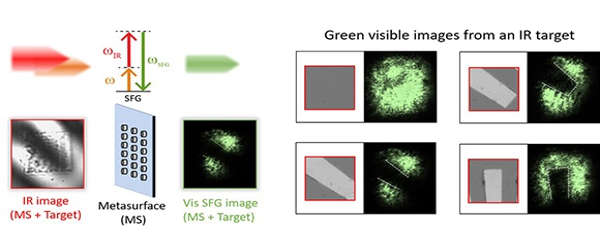Using ultrathin and transparent semiconductor nanocrystals, researchers demonstrate the conversion of infrared images to visible images.
Due to a wide range of applications ranging from food quality control and remote sensing to night vision devices and lidar, the demand for detecting infrared (IR) light, which is invisible to human eyes, is constantly increasing. Commercial infrared cameras necessitate the conversion of infrared light to electrons and the display of the resulting image. This display interferes with normal vision by blocking the transmission of visible light. Moreover, such IR detectors require low temperature and even cryogenic cooling due to the low energies of the IR photons, making IR detectors bulky and heavy.
The use of a nonlinear optical process to convert IR light into visible light is an all-optical alternative to traditional cameras. In this case, electrical signals are no longer used in the IR detection process, and the image, which has been converted to visible, can be captured by eye or a phone-type camera. Nonlinear sum-frequency generation is the optical process used in this technique (SFG). Two incident photons, one in the IR spectrum, interact within a nonlinear material to generate emission at higher and visible frequencies in the SFG process. However, conventional approaches rely on bulky and expensive nonlinear crystals for this conversion.
Researchers demonstrate the conversion of infrared images to the visible, using ultrathin and transparent semiconductor nanocrystals.
The use of ultrathin nanocrystal layers known as metasurfaces is a very appealing platform for overcoming these limitations. Metasurfaces are planar arrays of densely packed nanoantennas designed to manipulate incident light properties such as frequency. Dielectric and semiconductor metasurfaces, for example, have shown great promise for improving nonlinear optical processes at the nanoscale.
Due to the excitation of optical resonances and the good coupling to free space, such metasurfaces can exhibit enhanced frequency conversion. Thus, the use of nonlinear metasurfaces is a promising way to up-convert IR photons to visible and thus image IR objects using ultrathin and ultralight devices via coherent conversion. Transparent metasurfaces, for example, could perform IR imaging in a transmission configuration while also transmitting visible light, allowing for normal vision.

With this in mind, researchers from The Australian National University, Nottingham Trent University, and collaborators from around the world were able to demonstrate IR imaging using nonlinear metasurfaces made of small semiconductor nanocrystals. According to Advanced Photonics, the researchers created a multi resonant metasurface to boost the field at all frequencies involved in the SFG process. The designed metasurface was created and transferred to a transparent glass, where it formed a layer of nanocrystals on the surface.
Infrared imaging is used in a wide range of applications, including night vision, autonomous vehicle navigation, optical tomography, and food quality control. Traditional infrared imaging technologies, on the other hand, necessitate the use of materials such as narrow bandgap semiconductors, which are sensitive to thermal noise and frequently necessitate cryogenic cooling.
An IR image of a Siemens-star target illuminated the metasurfaces in the experiment. The target’s infrared image was mixed with a second beam and up-converted to a visible wavelength of 550 nm via the SFG process (green light). The visible green images captured with a conventional camera correspond to various transverse positions of the target, including the case where the target was completely removed from the path of the IR beam and SFG emission from the metasurface was observed. Despite the fact that different parts of the IR signal beam were up-converted by the metasurface’s independent nanocrystals, the images were well reproduced in the visible.
The proposed metasurface-based IR imaging approach opens up new possibilities not available in traditional up-conversion systems. For example, the use of counter-propagating excitation beams, incidence at various angles, and, most importantly, multicolor IR imaging by a properly designed metasurface. As a result, the researchers’ findings can aid in the future development of compact night vision instruments and sensor devices, providing an ultrathin and ultra-compact platform as well as new functionalities such as multicolor IR imaging at room temperature.
As a result, the researchers’ findings can aid in the future development of compact night vision instruments and sensor devices, providing an ultrathin and ultra-compact platform as well as new functionalities such as multicolor IR imaging at room temperature.















